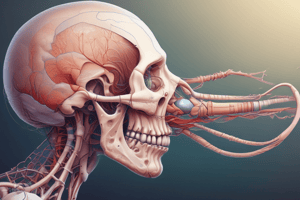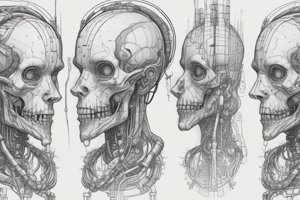Podcast
Questions and Answers
On what day of gestation does the development of the lens occur in humans?
On what day of gestation does the development of the lens occur in humans?
- 25
- 26
- 27 (correct)
- 28
All lens growth after the development of the embryonic nucleus can be attributed to
All lens growth after the development of the embryonic nucleus can be attributed to
- Primary fibers
- Secondary fibers (correct)
- Tertiary fibers
- Zero fibers
What do Y inverted sutures seen during slit lamp examination represent?
What do Y inverted sutures seen during slit lamp examination represent?
- Sites of lens proliferation
- Pathological changes in the lens
- Boundaries of the fetal nucleus (correct)
- Interfaces between primary and secondary fibers
What type of fibers form Y inverted sutures?
What type of fibers form Y inverted sutures?
Which structure connects the posterior surface of the lens to the anterior face of the vitreous body in the eye?
Which structure connects the posterior surface of the lens to the anterior face of the vitreous body in the eye?
Area of non-adhesion between the vitreous and retina
Area of non-adhesion between the vitreous and retina
What is the proportion of protein in the lens?
What is the proportion of protein in the lens?
What is the pH of the lens?
What is the pH of the lens?
What is the refractive index of the nucleus in the lens?
What is the refractive index of the nucleus in the lens?
What is the refractive index of the outer cortical surface in the lens?
What is the refractive index of the outer cortical surface in the lens?
Flashcards are hidden until you start studying
Study Notes
Y inverted sutures seen during slit lamp examination are from secondary fibers, they denote boundaries of the fetal nucleus
Refractive power 20 D in unaccommodated lens 1/3 of the lens is protein 2/3 is water PH 6.9 Protein contents varies among the lens with a higher refractive index – in the nucleus (1.50) – less in the outer cortical surface (1.37) Higher refractive power in the center
Refractive Power of an Unaccommodated Lens
- Refractive power refers to the ability of the lens to focus light in its natural, relaxed state.
- Refractive power formula: P = 1/F, where F is the focal length of the lens.
Units and Measurement
- Unit of refractive power: diopters (D).
- Measurement techniques: phoropter or autorefractor in a clinical setting.
Factors Affecting Refractive Power
- Lens shape and curvature
- Lens material and refractive index
- Pupil size and shape
- Corneal curvature and refractive index
Clinical Significance
- Essential in ophthalmology and optometry for diagnosing refractive errors (e.g., myopia, hyperopia, astigmatism).
- Crucial for prescribing corrective lenses (e.g., glasses, contact lenses).
- Important for monitoring lens changes during accommodation.
Accommodation and Refractive Power
- During accommodation, the lens becomes thicker and more curved, increasing its refractive power to focus on near objects.
- This process is reversible, and the lens returns to its unaccommodated state when focusing on distant objects.
Studying That Suits You
Use AI to generate personalized quizzes and flashcards to suit your learning preferences.



